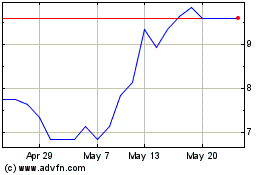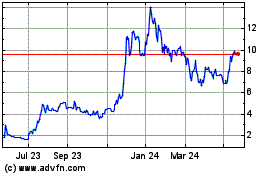TIDMEEE
RNS Number : 9055T
Empire Metals Limited
20 November 2023
Empire Metals Limited / LON : EEE / Sector: Natural
Resources
20 November 2023
Empire Metals Limited
('Empire ' or the 'Company')
Thick, Higher Grade Titanium Mineralisation Throughout First
Diamond Drillhole at Pitfield
Reverse Circulation Drilling New Highly Prospective Zones
Empire Metals Limited (LON: EEE), the AIM-quoted resource
exploration and development company, is pleased to announce the lab
results from geochemical analysis of samples from the first of
three diamond core drillholes completed at the Pitfield Project in
Western Australia ('Pitfield' or the 'Project') which confirm
strong TiO(2) mineralisation throughout the hole to a vertical
depth of circa 350m.
The next phase of drilling, an extensive Reverse Circulation
('RC') programme targeting higher grade mineralisation, has now
commenced.
Highlights
-- Strong titanium mineralisation confirmed throughout entire
first Diamond Core drillhole, from surface to end of hole at 408m,
providing further support for the presence of a district-scale,
metal-rich, hydrothermal mineral system containing multiple, thick
higher grade titanium zones within the larger mineral system.
-- Diamond drillhole #1 (DD23MTS001) intersected wide intervals
of higher-grade titanium mineralisation:
-- 276.5m @ 4.57% TiO(2) from 80.5m; including
o 118.5m @ 5.13% TiO(2) from 80.5m; and
o 144.8m @ 4.24% TiO(2) from 207.2m
-- RC drilling of higher-grade target areas has commenced, with
approximately 40 RC holes totalling 6,000 metres currently planned
to test the length of the coincident 30 km long magnetics-gravity
anomaly.
-- Recent rock chip sampling identified broad higher grade
TiO(2) drill targets, covering 3km(2) and 6km (2) respectively, and
these will be drill tested during the current programme.
-- The Company expects to have lab results for the remaining two
diamond drillholes available shortly and expects to be able to
release more information about key parameters such as mineralogy,
grades, and geological controls once the drill core assessment is
completed.
Shaun Bunn, Managing Director, said: "I am delighted to report
the lab results from our first diamond drillhole, which was
positioned towards the northern end of the massive 40km by 8km by
5km deep hydrothermal mineral system. These results have confirmed
that extensive and higher-grade titanium mineralisation extends
well below the 150m depth first discovered during our maiden RC
drill campaign, with this particular diamond drillhole ending with
higher grade TiO(2) values at 350m below surface, indicating that
the mineralisation continues to remain open at depth. We expect to
see similar lab results for diamond drillholes #2 and #3, which are
due out over the next few weeks.
"The next phase of drilling has now commenced, consisting of 40
RC drillholes which doubles that drilled in our maiden RC drill
campaign. This drilling will target areas within known strong
magnetics and/or gravity anomalies and areas of known high-grade
TiO(2) (as identified in our surface sampling). We expect this to
be another highly successful campaign, one which will establish not
only the district scale of this giant mineral system but also the
potential for extensive, higher-grade zones of titanium
mineralisation."
The Pitfield Project
Empire holds a 70% interest in Pitfield which is comprised of
four granted Exploration Licences (E70/5465, E70/5876, E70/6320 and
E70/6323) covering 1,042km(2) . Pitfield is located near Three
Springs, a town 313km north of Perth, Western Australia on the
Midlands Road, which until the opening of the Brand Highway in 1975
was the main road route from Perth to the state's north (refer
Figure 1).
Figure 1. Pitfield Project Location showing the scale of the
magnetics anomaly and coincident alteration footprint.
Summary of Drill Intercepts - Diamond Drillhole #1
(DD23MTS001)
Geochemical analysis lab results have now been received for this
northern most drillhole, located near Mt Scratch where the majority
of the maiden RC drillholes were completed. The final length of the
angled hole was 408.4m, ending approximately 350m vertically below
surface. The drillhole intersected a thick sedimentary succession
of interbedded sandstones and siltstones, referred to as the Mt
Scratch Siltstone formation. These sedimentary host rocks display
extensive and strong iron-rich alteration, including a steel-grey
hematitic alteration and a ferruginous brown alteration which
alternate throughout the hole. Chlorite and epidote alteration of
the host sedimentary rocks is also observed and varies in
intensities.
Commencing in titanium mineralisation from near surface,
DD23MTS001 intersected thick intervals of strong, higher grade
titanium mineralisation, including the following:
-- 276.5m @ 4.57% TiO2 from 80.5m; including
o 118.5m @ 5.13% TiO2 from 80.5m
o 144.8m @ 4.24% TiO2 from 207.2m.
See Table 1 for the lab results for each interval from Diamond
Hole #1 (DD23MTS001). The lab test procedures involve multi-acid
digest including Hydrofluoric, Nitric, Perchloric and Hydrochloric
acids in Teflon Tubes, with analysis by Inductively Coupled Plasma
Mass Spectrometry. The lab reports Ti values whilst industry
standard is to report equivalent TiO 2 values. The conversion
factor for Ti to TiO2 is 1.668.
It is important to note that the mineralized interval noted
above is contained within mineralized sedimentary beds which
continue upwards to surface to the west and are open below the hole
to the east (see Figure 3).
The results continue to confirm that Pitfield hosts a
district-scale titanium mineral system with multiple, broad, higher
grade titanium zones identified within the larger system. The
diamond drilling results clearly demonstrate the continuity of
thick bedded zones of higher-grade titanium mineralisation to a
vertical depth of 350m, still with elevated TiO(2) at the bottom of
the hole indicating that the bedded mineralisation extends deeper.
There is good correlation between zones of higher and lower TiO(2)
values observed in drillhole DD23MTS001 and the previously drilled
RC hole (RC23MTS003), collared 50m further east (refer Figure 3)
with the Induced Polarisation ('IP') chargeability response that
the maiden RC drilling programme was targeting. For example, the
intensity of the IP chargeability increases significantly from 80m
downhole in drillhole DD23MTS001, corresponding with the higher
TiO(2) values. The close association between higher grade TiO(2)
mineralisation and high IP chargeability response provides the
Company with an efficient, low-cost exploration tool for targeting
larger scale, higher grade zones within the district-scale mineral
system.
Figure 2. Grey-scale magnetics map overlain by airborne gravity
survey results with locations of diamond core drill holes and
maiden RC drill holes/IP survey lines.
Figure 3. Cross Section - First Priority Drillhole (DD23MTS001)
with higher grade TiO2 Intervals and the adjacent RC drillholes
from maiden drilling programme.
RC Drill Programme
The next phase of drilling, an extensive RC drill programme,
targeting higher grade mineralisation, has now commenced and is
expected to run for several weeks. The programme is planned for 40
drillholes totalling 6,000 metres along the length of the
high-density gravity core within the regional magnetics anomaly
(see Figure 2), with particular focus on the high-grade areas
identified through the recent rock chip sampling and geological
mapping. The objective of this drill programme is to further define
the scale of this district-wide, titanium-enriched mineral system,
to carry out initial drill-tests of higher-grade targets and to
understand the distribution of key factors better, such as grade,
mineralogy, thickness and extent of mineralised beds and controls
on high-grade titanium mineralisation.
Figure 4. Photo of RC Rig at Pitfield Project, November
2023.
Table 1. Diamond drillhole #1 (DD23MTS001) geochemical analysis
lab results for TiO 2 *
(*Conversion factor for Ti to TiO2 is 1.668.)
Competent Person Statement
The technical information in this report that relates to the
Pitfield Project has been compiled by Mr Andrew Faragher, an
employee of Eclipse Exploration Pty Ltd, a wholly owned subsidiary
of Empire. Mr Faragher is a Member of the Australian Institute of
Mining and Metallurgy. Mr Faragher has sufficient experience that
is relevant to the style of mineralisation and type of deposit
under consideration and to the activity being undertaken to qualify
as a Competent Person as defined in the 2012 Edition of the
'Australasian Code for Reporting of Exploration Results, Mineral
Resources and Ore Reserves'. Mr Faragher consents to the inclusion
in this release of the matters based on his information in the form
and context in which it appears.
Market Abuse Regulation (MAR) Disclosure
Certain information contained in this announcement would have
been deemed inside information for the purposes of Article 7 of
Regulation (EU) No 596/2014, as incorporated into UK law by the
European Union (Withdrawal) Act 2018, until the release of this
announcement.
**S**
For further information please visit www.empiremetals.co.uk or
contact:
Empire Metals Ltd
Shaun Bunn / Greg Kuenzel Tel: 020 4583 1440
S. P. Angel Corporate Finance LLP Tel: 020 3470 0470
(Nomad & Broker)
Ewan Leggat / Adam Cowl
---------------------
Shard Capital Partners LLP (Joint Tel: 020 7186 9950
Broker)
Damon Heath
---------------------
St Brides Partners Ltd (Financial Tel: 020 7236 1177
PR)
Susie Geliher / Ana Ribeiro
---------------------
About Empire Metals Limited
Empire Metals is an AIM-listed (LON: EEE) exploration and
resource development company with a project portfolio comprising
copper, titanium and gold interests in Australia and Austria.
The Company's strategy is to develop a pipeline of projects at
different stages in the development curve. Its current focus is on
the Pitfield Project in Western Australia, which has demonstrated
to contain a newly recognised giant mineral system that hosts a
globally significant titanium discovery. The Company is also
advancing the Eclipse-Gindalbie Project in Western Australia, which
is prospective for high-grade gold and also kaolin used to produce
high-purity alumina, an essential component in lithium-ion
batteries.
The Company also has two further exploration projects in
Australia; the Walton Project in Western Australia, and the Stavely
Project in the Stavely Arc region of Victoria, in addition to three
precious metals projects located in a historically high-grade gold
producing region of Austria.
This information is provided by RNS, the news service of the
London Stock Exchange. RNS is approved by the Financial Conduct
Authority to act as a Primary Information Provider in the United
Kingdom. Terms and conditions relating to the use and distribution
of this information may apply. For further information, please
contact rns@lseg.com or visit www.rns.com.
RNS may use your IP address to confirm compliance with the terms
and conditions, to analyse how you engage with the information
contained in this communication, and to share such analysis on an
anonymised basis with others as part of our commercial services.
For further information about how RNS and the London Stock Exchange
use the personal data you provide us, please see our Privacy
Policy.
END
DRLBKLLFXFLEFBZ
(END) Dow Jones Newswires
November 20, 2023 02:00 ET (07:00 GMT)
Empire Metals (AQSE:EEE.GB)
Historical Stock Chart
From Oct 2024 to Nov 2024

Empire Metals (AQSE:EEE.GB)
Historical Stock Chart
From Nov 2023 to Nov 2024
